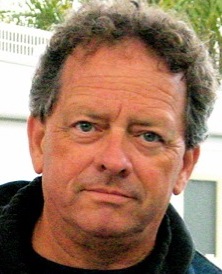The Windhook Interview—Chris Anderson and Will Carlton
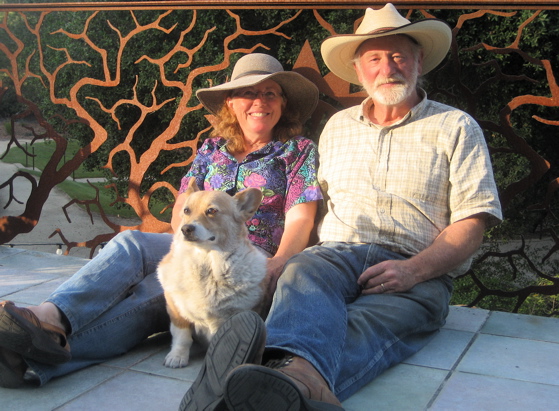
Chris Anderson and Will Carlton are some of the most inspiring role models we have ever seen. It makes our heads spin to try to keep up with all the remarkable adventures this couple is engaged in, and we have been wanting to interview them since the very beginning of Outside the Lines. In fact, their story was one of the early influences that inspired us to start writing these notes. One thing to notice as we talk to them is that they have a fearless and unreserved capacity to jump off the edge into new adventures, building on the ever widening field of their experience. One thing leads to another, and as the old adage suggests, preparation leads to opportunity. I will almost certainly write more about this later. And as you will see, these two are very busy people, but finally, we have pried open a tiny window in their tight schedule to sit down and talk! So pour a cup of coffee or tea and settle in. It's a good read.
Michael: Let's start off with your backgrounds. You can each chip in, and tell us about where you came from and how you got to where you are today. Let's start with you, Will.
Will: I came from Colorado. From Cripple Creek. A gold mining town. I grew up there.
Peggy: Where is that near?
Will: It's on the other side of Pike's Peak from Colorado Springs. A town of 500 people. My dad's a mining engineer. I left there to go to military school, which was really fun. It turned me completely against the military.
Michael: Was that your choice?
Will: Not really my choice. My folks, who had no idea what the military was about, sent me to military school because the schools were so poor. It was a very small population. So it was a great thing, because I became a complete pacifist after all that, and hate the military and all the concepts in there.
Michael: OK then.
Will: I went to the University of Colorado, because it was the biggest party school I could find after military school. I almost got a degree in civil engineering, and then I came to Cal Poly to go to the school of architecture. In my last year of architecture, I had a chance to take a glass blowing class. I had taken one art class at university of Colorado. But I was enthused about taking this glass class. I remember always as a kid liking to blow things up and play with fire. So I graduated and started to blow glass and never looked back.
Michael: So that means you didn't do architecture.
Will: No. I got the degree, but I never worked in an office. It was kind of a bad time in '73 to get an office job. Most of the guys I graduated with did get a job in architecture.
Chris: But you did remodeling and building and that sort of stuff.
Will: Yeah—to pay the gas bills I turned to remodeling and did a bit of building.
Peggy: Your dad was a mining engineer, and you went into civil.
Will: Yeah. Pretty much because he was an engineer, I thought I would be an engineer, but I didn't know why. Really I was always more artistically inclined anyway.
Michael: How did you switch to architecture? What made you think of that option?
Will: As a kid, I knew of an architect in Santa Fe who was also an artist, and I thought, "Oh! You can do that? You can be legitimate and still be an artist?" That sounded like it was kind of fun.
Michael: So you had an early inclination toward art.
Will: I think so.
Chris: Well, talk about your friend's mother who was the art teacher.
Will: Yeah. She taught my buddy and me to paint signs early on. We painted a lot of signs. So I was at least doing 2-D graphics.
Chris: But he did a lot of signage for stores in San Luis in the early days.
Will: When I first came here.
Chris: Back in the day when people still dragged a brush.
Will: I did the Flying Dutchman Restaurant in Morro Bay. I designed the sign to look like an old board and peg thing. Like a gang plank. And it had a four and a half foot tall sculpture of the Flying Dutchman—out of metal. I think I got my first oxy-acetylene outfit to weld that together. And I routed the letters into it and put it up in the air in Morro Bay over several windy days, working on ladders. I hate heights, but I managed to get a welded sculpture and routed sign up on a huge billboard. It was my second year of architecture here—scary.
Peggy: Now they've changed the name of the restaurant. It's now "The Dutchman" I think.
Will: Yeah.
Peggy: Was anybody in your family in art?
Will: Not really. No. My mother was a musician, but that was about it.
Michael: [Turning to Chris] And what about you? Where'd you come from?
Chris: Atascadero.
Michael: Atascadero!
Peggy: You've come so far.
Will: By way of Thousand Oaks.
Chris: Yeah. I was born and lived in Thousand Oaks until I was nine. Then my family moved to Atascadero. So I pretty much grew up there. But I was always interested in arty things.
Will: Good with your hands, sewed a lot.
Chris: Yeah. I made all of my own clothes when I was in high school. My parents did a really cool thing. Then it was more economical to make your own clothes. It's not so much now. But I was the oldest of three girls, and they said, "If you want to make your own clothes, we'll buy all the fabric you want, as long as you finish things. But if you want store bought clothes you have to buy them yourself." So it was a no-brainer. So I sewed a lot. Then I started doing a little painting. But I've collected rusty metal for over 40 years. Now everybody does, but back then, I was a weirdo. I'd go the the scrap yard, and haul all this stuff home, and make stuff.
Peggy: In Atascadero?
Chris: Yeah. Down in my office I have the very first things I made. One is a stack of little gears that are painted—remember the tiny little jars of paint that are for models?
Michael & Peggy: Testor's.
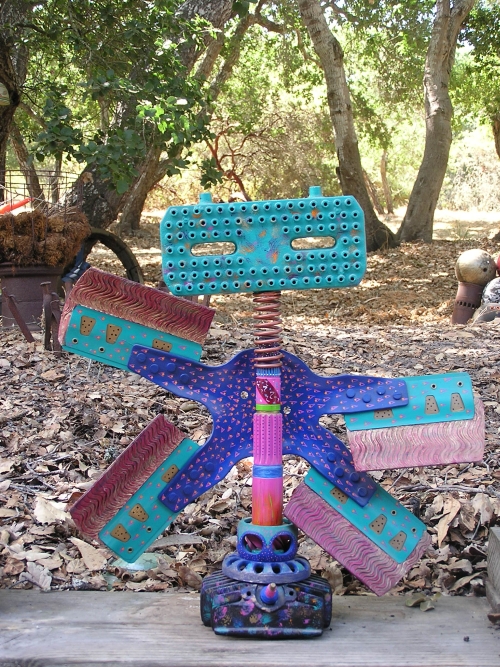
Chris: Yeah, each part is painted with a different color of Testor paint. And the other thing was the inside of a door lock. And when you look at the inside it has all of these really cool things, and it was like a little shadowbox. So all of the little latch parts and the spring and everything are painted a different color. I have that hanging on my wall in my office. I did that at least 40 years ago. Then for a long time it was just fabric stuff and then I started doing more metal. My first metal sculpture that I did was—Deb Engles who does the blues show on KCBX—her husband Bill had a business making radiators for antique cars and when he bought that business I made this sculpture out of a brake drum and a whole bunch of radiator caps and it hung by a dipstick and I had these wooden parts that I cut out and it was painted these wild colors and it looked kind of like something in outer space and it was called "To the Moon Alice." And I gave that to Bill for his birthday and that started the whole painted metal sculpture thing. Because Bill had a big sandblaster in his business and I could go there and sandblast all the parts. After all the years of collecting rust then I was taking rust off.
Peggy: You don't still have a stockpile here do you?
Chris: Oh yes. It's up the hill. It used to be out there and then when we did the landscaping it had to move up the hill. I knew Will was the man of my dreams when he moved my rust pile from Atascadero to here. That was quite the indicator.
Will: Big, dumb and really strong.
Chris: I have a picture of him on the back of the trailer piled high with rusty metal.
Will: Tons, tons of rusty metal.
Chris: Someday. But in the meantime in 1985 Will came in to KCBX to donate something to an art auction that we were having. And the Development Director introduced us and I had seen glass at the Seekers Gallery but had never seen anybody blow glass but I wanted to know how to do it. And so I asked him if he taught classes and he said "Sure!" Well, I was his only student.
Peggy: "Private" lessons.
Will: Worked for me.
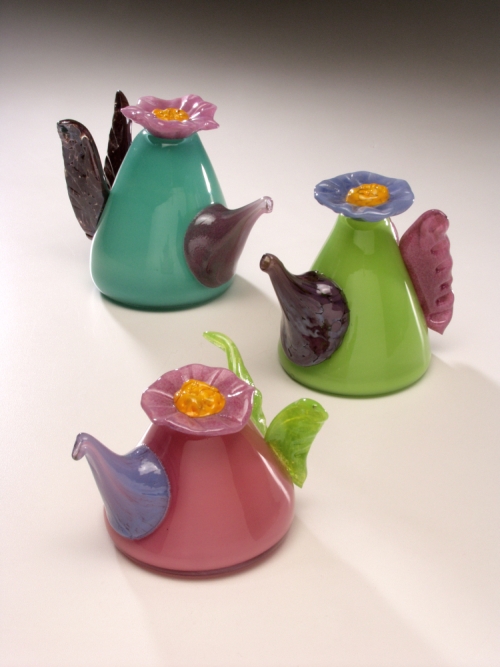
Peggy: Who needs etchings when you've got glass?
Chris: And as he says I had to go away to glassblowing school to unlearn everything he taught me. The way that he used to blow glass is different from everybody else. The bench that he used was one that had rollers and the pipe stayed in one place. And I went to the Penland Craft School in North Carolina in 1986 and they used the traditional bench with the rails that everything goes back and forth on it. That worked so much better for me because the back and forth kind of corrected if you're off going one way when you come back it corrects it. Whereas is you're constantly turning in the same direction so anyway I came back and then he built me a new bench like the ones Penland had. I measured everything and he built one.
Will: Chris brought the traditional glass bench to the studio and also a great glass formula which was Spruce Pine glass. It's from Spruce Pine, NC. They batch glass for a lot of glass blowers. That was a great advancement to the studio besides having a new assistant.
Michael: So you went to Penland?
Chris: I've been to Penland three times.
Will: I've been twice.

Chris: I went to Red Deer College in Alberta twice. One class with Laura Donefer who is the Wild Woman of Canada glassblowing she's fabulous. Then I went for another class in kiln casting which was amazing. The guy taught this really wacky way of making molds. I can show you some downstairs in the studio.
Will: We used to go to classes fairly regularly. We either would go together or separately. I went to Pilchuck early on but it was several years after that that we both felt that we could either go to conferences using the Glass Art Society or something kind of related or we would go to a craft school to get some craft education. To back up a bit Chris really did have to unlearn a lot because I was completely self taught because I took the first glassblowing class at Cal Poly which was taught by Henry Wessels who was a ceramics instructor. And he never had blown glass.
Peggy: I didn't know he did glass.
Will: Our first assignment was to go to the library and find out to blow glass so that's what we did. But Henry got the glass program started and then three years later George Jercich came. But I was long gone from that scene. George used to come to my studio to blow glass because he didn't want to use State money to make his own pieces. He was very forthright about that so we got to know each other very early on. But because I was pretty much self taught and developed strange habits and strange tools and strange ways of doing things that then allowed me later on to do things that no one else could figure out, and why would they want to maybe but there were things that I was able to do.
Chris: For years he would blow glass by himself and so he had all these contraptions that enabled him to do it by himself and that was the way really for a long time in the United States. And then studio glass started moving more towards the Italian, European model of teams. And so when I went to Penland the first time it was still kind of you're on your own.
Will: Individual artists.
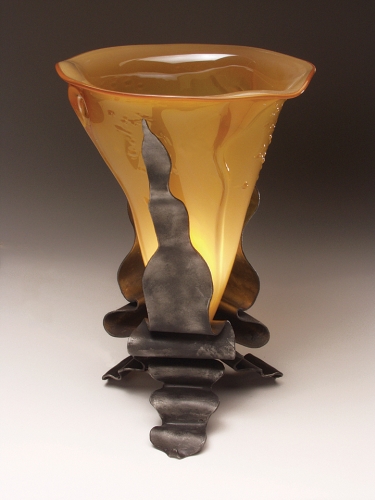
Chris: And by the third time I went it was really more team. We had a partner. If you could talk someone into helping you before it was ok. Also at Red Deer you had a partner that you worked with so it made it so much easier.
Peggy: So at Penland how long were the classes?
Chris: The first time I went I went for three weeks and it was over Thanksgiving and it snowed. It was fantastic.
Will: It's a beautiful place.
Chris: It's out in the Blue Ridge Mountains and it was just wonderful and the instructor that I had, Rob Levin, is just one of the most wonderful people in the world.
Will: He's a special guy.
Peggy: And where is he?
Chris: He's from right there, down the road. But I had seen his pieces at the Seekers Gallery. Hamburger goblets. The bottom of it looked like a hamburger with the lettuce and the bun and tomato and everything and coming out of it was this goblet. Wacky. And he did fish with this really life like looking trout with a foot on it and then a goblet.
Will: He was well known for those. He was a great innovator in glassblowing.
Chris: His whole family was there. They have this cabin. And his twin girls who were just a couple of years older than my daughter Risa and his wife were there for the whole time. So it was neat. I helped the girls do their homework.
Michael: So for a long time I gather that you were mostly involved with glass. How recently have you started branching out into all these other things we know about?
Will: The first major other thing we started to do was to have craft fairs here.
Chris: Well no the first major other thing we started to do was plant all of 1500 olive trees in 1998.
Peggy: So where did that idea come from?
Will: We had this half of the ranch. The next parcel over was available for purchase and I probably would have obtained it first but it wasn't available. It had a lot more usable land and when we got it it had a few straggler apricot trees that had been planted in 1911 so local folklore goes, for the World War I effort. They dried the apricots and sent them to the guys in Europe. So it had been a working fruit ranch more or less which we didn't know anything about historically.
Chris: It was clear. That ten acres was cleared.
Michael: So that was the ten acres where the straw bale house is now.
Will: Yes and I felt as though that we could see our way clear to work and own this piece but that part had to work for itself. I didn't realize I was going to work for it. So I got this idea to plant olive trees. I don't really remember if there were olive plantings going on in Northern California. There were a few people doing it. I don't know how I even really first heard about it. I remember back thinking that manzanita trees kind of look like olive trees to me and I'd always heard that botanically if something looks like something else it will probably do well.
Chris: That's just how much he knows about it.
Peggy: Enough to be dangerous.
Will: It was a false thing to start with but I knew they'd do well here because it's the right kind of climate. And then loving food and olive oil and Italian cooking I decided to plant olives. There was a man out on Schoolhouse Road out on the way to Huasna who was growing olives. I went and visited him and he had been a missionary and the way he planted olives was he wanted to plant one of everything that was in the Bible. That way not my reason for sure but he had some knowledge of planting olives and olive oil.
Chris: They had been in Palestine and Israel and that's where he found about how to make oil.
Will: And he didn't know anything culturally about olives. He never pruned his trees but he did make some olive oil and he sold vinegar and oil cruets and he was a gentleman farmer who played with it. He was enthused and I wanted to plant olive trees and he gave me some guidance. Chris and I used to go to the eco farm conference and we met Amigo Contesano and he knew a guy named Phil Couturi. Phil's partner in organic farming in Sonoma used to shovel produce in the back of Alice Waters place. They were very close to Alice and she helped promote them. Those guys had gotten enthused they had gone to Italy and gotten the wood the cuttings because you can't bring live plants or soil in. Our trees are actually started from cuttings from Phil Couturi. So that's how we got started. We got 1500 trees planted.
Chris: At that time it was really hard to find anything other than Manzanillo and Spanish Mission olives so to find the Italian varietals that we have. Now they're all over.
Peggy: The mission olives are for eating?
Chris: For either but it's just a different flavor profile.
Will: I think I always wanted to be a farmer. I didn't find out till years later that my Father's favorite uncle had become a farmer when he'd been a professional engineer. He grew produce and took it into the city.
Chris: The uncle you're named after?
Will: Yes, Willard Gilbert Carlton was a farmer.
Peggy: Where did you live before you lived here?
Will: I lived in a studio. I lived in a warehouse for 20 years in San Luis.
Chris: I always referred to it as his "hovel."
Peggy: Charming.
Will: That was before the days of "man caves" now it's hovel.
Chris: Now it would be called a "Man Cave."
Michael: So you were together when you got this place.
Peggy: What was the idea behind this place?
Chris: The original plan was, I have no idea. This was going to be a wood shop and an I don't know what. We were not going to live here. The house and the glass studio were down that little road down there. All the utilities are there for it and the plans are drawn and then it kind of became apparent that it would take too long to do all of that and so we figured out a way to make this a living space and that into the glass studio.
Will: Chris was at work at KCBX and called up one day and said there's this great premium if you want to take a class with a timber frame group. And I said yeah, for $65 I was able to save 10's of thousands of design fees to build this barn. So I went and took a timber frame class with Pacific Post and Beam, Terry and his guys, and fell in love with timber frame.
Chris: So they were building a gazebo at Lake Cachuma and they took the class down there to work on that. And from that, he designed this.
Will: We had several of Terry's guys work on this with me. I had it all designed and engineered and through the permit process. I had made the sawhorses, I ordered the wood and I was ready to make the first cut with a slick one inch chisel and I called Terry and asked can I borrow your mortiser? I don't want to borrow your tools, can I get one of your guys. And Terry said all of them are out of work right now but if you'd like to hire them. So I had 5 experienced timber framers cut joints for like three weeks and we put it up in about a week and didn't finish it for another 5 years.
Chris: Three years before we moved in.
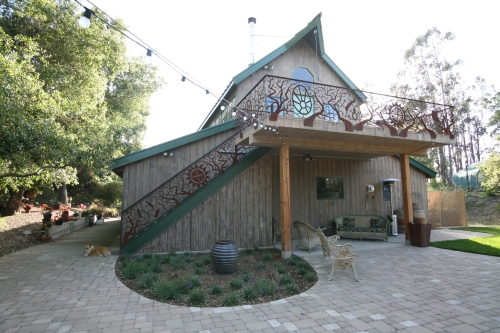
Will: To completely finish it.
Chris: Well, it's still not finished.
Will: Yeah.
Michael: So we're here looking at the place but describe it for our readers.
Will: It's authentic timber frame with allowances to the engineers and the State of California for earthquake safety. But these guys are really good at hiding all the nuts and bolts and of course anything under the slab you can't see. It is not built in the typical convention of short bents. I built it taller. My bents were going the opposite way.
Peggy: Bents being?
Will: A bent is a section, typically this whole side would come up. Normally there would be three bents but this one is four bents in the shorter direction. The basic center gable. It looks like a prairie barn to some extent but the upper structure is a hammer beam design. There are parts of it that are from Dutch barns, from English barns, the hammer beam being a Dutch design. The rest of the joints are historic probably Japanese, probably commonsense woodworking joints, post and beam, mortis and tenon joints with oak pegs.
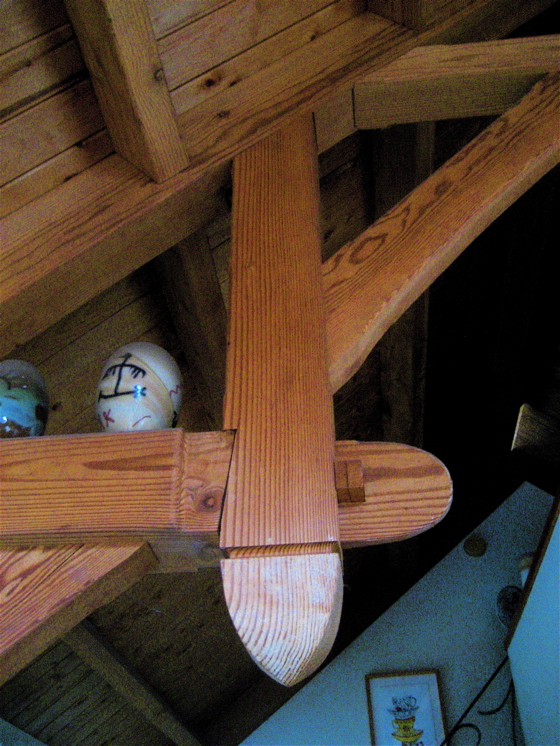
Chris: But I think one thing for people who don't know what timber frame means, the whole structure is put together with just joinery, no nails or screws.
Michael: Interlocking wood joints.
Will: There really are no nails.
Chris: Of course the skin is put on with fasteners but the structure itself is not.
Will: It's a giant piece of furniture. When they came to measure for the roof, the roofers were amazed that it was 1/8th inch out of square in 50 feet. I think they were wrong myself. But it was amazing to them that it was that square. Well there was no way that it could have been out of square the way it was built. We cut the joints to within a 7 mm pencil. So you cut to one side or the other and so we were cutting to the center of a 7 mm pencil so it was pretty tight.
Michael: And the bottom floor is your glass shop.
Chris: Half of it is the glass shop and then the back half is the catering end.
Will: We use it to assist the caterers and for storage.
Chris: And when we're showing our glass it's our glass gallery so it's a multipurpose space.
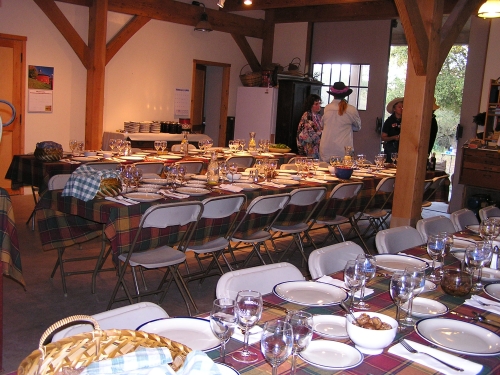
Michael: My main connection to the downstairs is the party at the end of the olive picking events.
Chris: And that too.
Michael: And the glass events, the holidays and selling a lot of glass and things.
Will: It is definitely a multipurpose barn. Life is just one big event for us.
Michael: Yes
Will: From weddings. A dozen at least weddings a year to four days of craft fair to four days of food events based around olive oil and all of our friends who are artists and all of our friends who make food come here. All of our friends who come pick our olives which is usually two days maybe one day. In the early days it was one day now it's two days. 100 people help pick olives and we feed and humor them through the process.
Michael: I've felt very humored.
Peggy: Very, very well fed and very well humored.
Will: We've had some good food and some good times.
Michael: So talk a little bit about the craft fair events.
Chris: We have 30 other three dimensional artists who usually show, and we have our glass furnace running and we have it set up so people can watch different glassblowers. A lot of local glassblowers come and show their work and then take turns doing demos so people can see different styles of glass blowing. Last year was fun. Carlos and Sophia Covarubias from Ruby glass down in Nipomo have three kids, and the whole family worked together on a piece. I think their youngest is seven and their oldest daughter is fifteen or sixteen. The five of them were working on one piece and it was real fun.
Peggy: Did all these things just evolve or did you have a vision for having these kinds of events?
Chris: They have evolved. Some of the things have taken on lives of their own and go where we had no idea they would go. If we had laid this all out at once with one big vision, I think we would have been scared off very quickly.
The craft fair has grown from us, and see that mosaic tile over there on the wall? That's Lucinda Nichols. She was our neighbor, and she made the tiles and was doing this mosaic. Was it for Open Studios, or was it before Open Studios?
Will: I think it was before Open Studios.
Chris: So we just had this thing. The downstairs was still a woodshop, so there was this huge band saw there, and we used the table of the band saw to put food on, and that was the first one. And then the next year somebody said, "Gee, can I come too?"
Were you here before we landscaped the back yard?
Peggy: Yes. You still had the fire ring out in back.
Chris: We used to have everything out in front. So it has just mushroomed.
Michael: Well, the work you have done in the back yard is just remarkable. It's dramatic back there.
Will: That's all Chris's work. It kind of designed itself. We knew what we wanted.
Chris: We designed it of course, but the space itself dictated what it was going to be. Some people bring in bulldozers and landscape the heck out of it and change it. We left the topography like it was and utilized that.
Will: Chris's friend, Michael Barry, who is an accomplished landscaper, helped us out.
Chris: He came out a couple of times, and he actually designed the patio below, and the lawn. He just dragged his foot along and made an outline, and it was so much better than what we had. Then he also helped with the initial plant choices. He also chose the Carex praegracilis, which is the native grass that theoretically doesn't need as much water.
Michael: And you're maybe the only people I know who have a functional music stage in your back yard.
Chris: Yeah.
Michael: You have concerts in your back yard.
Will: Which we would like to do more of.
Chris: We're having the KCBXtravaganza not this weekend but the next weekend.
Michael: That will be the weekend before we publish this.
Peggy: It's also the weekend of the Paso Robles Festival of the Arts, that Michael is in, so we'll miss it for that.
Michael: Yeah, we'll be tied up that weekend.
Will: There's a lot of musicians at KCBX.
Michael: Our readers will probably gathered this by now, but you [Chris] worked at KCBX.
Chris: I was the assistant station manager for 13 years.
Will: And you started Live Oak.
Chris: I helped to start Live Oak, ok. Don't say I started Live Oak.
Peggy: You were instrumental.
Chris: And I was the co-director of the festival for ten years, with Jim Mueller.
Peggy: Wow, that is a long time.
Will: And now we sell popsicles at the Parkfield Bluegrass Festival.
Chris: And Live Oak.
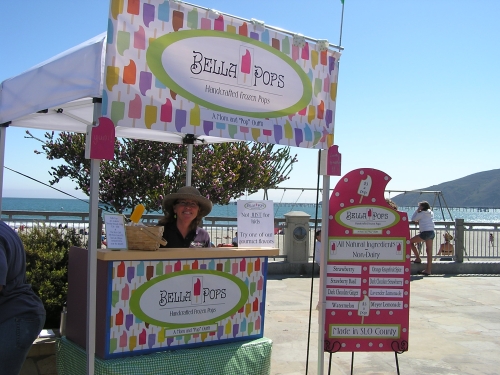
Michael: That brings us to another branch of your varied and diverse empire. Tell us about popsicles.
Peggy: You're a conglomerate all your own.
Chris: When people ask me how that started, I say, "The universe just said popsicles." It's so weird. I have no idea where it came from. But not last summer but the summer before, when we were getting ready to go to Live Oak, I thought, "I'm going to make popsicles and get dry ice and take them down there and share with everybody in our camp." So I looked up a bunch of recipes I thought would work, and made about five different flavors, and everybody loved them.
Will: It's why they call her the mom of Live Oak.
Chris: So in the back of my mind I thought, [whispering] "You know, this could be a business—Shut up!" And in the middle of Live Oak, Will said, "You know, you could make this into a business." And I said, "I know."
Peggy: "But shut up!" [laughter]
Chris: But shut up. So after that I came back and did a little research on it and found out that popsicles are the next cupcake. They're getting really popular. So I started looking for where to get molds and where to get all the equipment to make them. It was one of those things that was just meant to be. I don't know why.
Will: And somebody kept putting popsicle molds in the mail box.
Chris: Yes. After Live Oak, for a couple of weeks, eery couple of days I would go out there and here is another little popsicle mold. And I asked, "Who is it!?" I asked Risa, and I asked everybody who was at Live Oak, "No, no, no." [Laughing] It was Will.
Michael: So what kind of popsicles are these?
Chris: They're all non-dairy, thanks to the dairy rules in the state of California that we can't comply with, because nothing else can be made in that space. So you have to have a clean room. We have a commercial kitchen but not a clean room. And they're all made with fresh real ingredients. No artificial flavors or colors or anything like that. The strawberries are from down in Arroyo Grande, the lemons I pick from friends back yards, the chocolate ones are made with Belgian chocolate and cocoa and water and sugar. So there's not cream in them but they're really good. [We had chocolate popsicles for desert after the interview, and they were incredible!]
Will: They're made in a commercial kitchen in San Luis Obispo, and then we sell them.
Chris: I have a special popsicle freezer thing now that freezes them in 15 minutes. I waited for that for seven months.
Peggy: Oh, that was the thing—you had to go to Florida, and...
Will: Chris was one of the first women graduates of the popsicle class in Florida.
Chris: I was in the first popsicle class given in the United States.
Michael: In the United States—where did these popsicles come from?
Chris: The molds are from Brazil. The machine is actually a knockoff from China of the ones made in Brazil, made by this guy who offered the class. But I had to wait for seven months. I ordered it in November, and got it in August—that's more than seven months. So all last summer we were making them in a chest freezer with dry ice and a fan. It took 3 hours to freeze a batch instead of 15 minutes.
Will: So life is a lot easier now.
Michael: There's one other thing I wanted to ask about that I've heard about recently. I don't know if it's a going concern or just a little experiment, but I believe you were building some sort of a Pizza oven on a trailer?
Chris: We have to take you downstairs so you can see the pictures of the pizza oven. It is beautiful!
Will: It came out really nice.
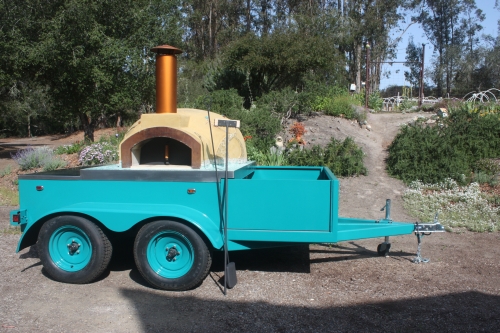
Peggy: So you built one?
Chris: It belongs to Nicola and Jackie at Mama’s Meatball in San Luis.
Peggy: And do they use it for...
Will: It's a concession size mounted on a trailer he takes it out to...
Chris: Events
Will: He caters...
Chris: Weddings, he's doing a wedding this weekend with it. He was at the Mission Plaza at the kids fair.
Peggy: So how did you get into the pizza oven idea?
Michael: Yeah, where did that come from?
Will: Well, the only thing I brought to it was the fact that I've been making glass furnaces for 40 years, and Nicola's catered events here several times, and he said he would really like to have a wood-fired pizza oven. And he's been actually working in front of a wood-fired pizza oven since he 13. He's got a lot of experience, so he was really excited to talk about building one. So I said I'd made glass furnaces, and it didn't sound like too big of a deal. It took me six months to make the mold and make the trailer, but I do have the mold now.
Michael: So the second one wouldn't take so long.
Will: I don't think it's going to take six months. But John Machamer, who has been our glass apprentice for the past 12 years is an excellent welder, and I just cut and fit parts and he welded it up. And we went on into the body work and the stainless steel health department—not requirements, but they're certainly going to be happy to see it.
Chris: At the end, when it was almost done, they said, "We want you to do a mosaic."
Will: I said, "Sure, I think I can do that." I had never done a mosaic in my life.
Peggy: Is it out of glass?
Will: Actually glass tiles that they purchased at Matt Clark. And they're beautiful.
Chris: But then there are some blown glass pieces on it.
Will: And some copper work.

Chris: I took some pictures of it.
Will: It's stuccoed over several layers of insulation and refractory, so they picked the color for the stucco, and then Jackie said, "Could we do a rag roll decoration around that?" We have a painter working up here, a studio painter, who's an incredible artist...
Chris: We're renting the house out as a painting studio.
Peggy: That's a great idea. With those big windows and great light.
Chris: Debra Sievers has been teaching classes up there, and she paints up there.
Will: So she cut her teeth on trompe-l'oeil and all kinds of faux painting, and she's really good at it. So I saw Debra as finishing this piece out. And they know her personally, and they get along really well, but they just didn't want it painted. so Jackie asked if I would do a mosaic. And She was thinking about vines, like grape vines, or tomato vines with tomatoes. But I wanted to do flames because I'm a glass blower, so I designed these vines that looked sort of like flames. It's kind of a free flowing design. Every other mosaic I've seen is completely solid mosaic. These are more or less growing through the stucco. When I got out to the finer filigree work of the branches, I turned to copper and then there are hand blown glass jewels on the outer points of those.
Chris: And they came for our Tomato Fandango on Sunday and made pizzas in it for the first time.
Will: He made 60 pizzas in about four hours. He can do one every two minutes if the temperature is right. It fires at about 700 degrees. They were excellent pizzas. We had roasted pepper and anchovie and capers and he did the typical pepperoni. They're basically Italian, thin crust wood fired pizzas. We look back on so many things we have done, and we're basically Italophiles. We've been to Italy several times. We had to research olive trees, and olive oil. So this is another Italian connection.
Peggy: You must have been Italian in another life. So trips to Italy came before olives or after olives?
Will: After we planted.
Peggy: Is there a future for the pizza ovens?
Will: I think so. We have some feelers out to do some more. There are a couple of people who are very interested. I'm thinking about doing some concession trailers right now too, because that's kind of a happening thing. I just designed one and turned it out today.
Peggy: Not a pizza oven?
Will: Just a basic concession trailer. We'll see.
Michael: Is there a future for a popsicle concession trailer?
Chris: We have been talking about it. Most of the events we go to don't have a place for a trailer. We're better off with a cart.
Will: I think the thing that's going to happen some day, is the people from Kosta Boda are going to come here and buy our glass design, but they really want to make popsicles, and have a concession.
Chris: Someone from Kosta Boda actually called, about eight years ago. The ornament that Will makes that has the candy cane hanging on the thread?
Peggy: Yes.
Chris: Well, they were interested in that. And they said they wanted him to design some other things. And then they went away and never called back. And now every time the phone rings he goes, "Is it Kosta Boda?" [laughter]
Will: But they really want to make popsicles. It's like selling popsicles to Swedish people.
Michael: So you mentioned the house.
Chris: Yes.
Michael: It's now being used as a painter's studio. But that's not what you built it for.
Will: We didn't? [laughter]
Michael: That's not the impression I had—for the last how many years?
Chris: Ten.
Michael: And it's a straw bale house, right?
Chris: It's a straw bale, and I describe it as very Ken and Polly-esque. It has their vernacular, definitely, and the soffits, and...
Michael: And the curved lines.
Chris: Lots of curves, and the soffit lights. It's fantastic.
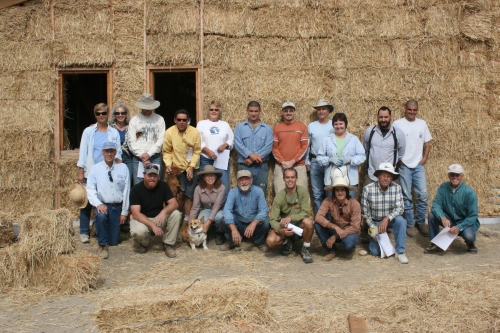
Will: It's gonna be a nice house.
Chris: And some day, some millennium, we'll live in it. But in the mean time, this 400 square feet that we live in is perfectly lovely.
Michael: And we never described the upstairs of your barn when we were talking about it earlier. The upstairs is where we are right now and it's where you live.
Chris: Right. And it's 400 square feet with the loft which is where our bed is.
Peggy: Wow. It seems so spacious.
Chris: Well, there are lots of built-in things. And the windows are looking out through the trees...
Peggy: That you glazed, right?
Chris: He not only glazed them but he welded them.
Michael: You built the frames.
Will: Yeah. I didn't glaze them all. I welded all the frames and had them powder coated. It was all just out of one by one angle, and eighth by half inch or eighth by three quarter inch strap, and then tack welded.
Chris: A bunch of our friends who needed jobs at the moment glazed them.
Will: We had friends who were leaded glass artists, and they were all very good. We had heat lamps with mounds of metal sash putty warming up and we had tables set up. There's 440 windows in this building.
Chris: And to wash the ones up here I have to put on a climbing harness, open one of those windows all the way, that little skinny window, and climb out on the roof.
Will: I could never understand why we didn't ever think about washing windows.
Chris: That's why they're so dirty. I only do it once a year.
Will: I never thought about washing windows, I just thought about how the light would look with all those panes.
Peggy: They're beautiful. Yeah.
Will: And to Chris it's P A I N.
And I didn't really design that in the original building plans. I just created some window space. I just made some big holes, so I thought, " They don't fit a standard frame so I guess I'm going to have to build those." I didn't look at the Anderson catalog first.
Michael: That's quite remarkable though. I mean they're beautiful.
One question I have about the glass blowing. We know a few glass blowers, and in fact we're going to interview George Jercich soon. But when he fires up the glass furnace, he basically doesn't leave the barn.
Will: Pretty much. Yeah.
Michael: So when you have the furnace going, how long do you run it and what does it do to your life?
Chris: That's one of the reasons why we don't blow glass so much anymore.
Will: It is very time consuming and it's all encompassing. I used to have the furnace on 12 and a half months every year.
Michael: Wow, that's a long time.
Will: It is kind of a ball and chain. Unless you own really expensive safety equipment, you're always on point.
Chris: And it's very expensive. It's like $900 a month.
Michael: Just for the gas.
Will: Yeah. So what that means is when the furnace is on we can't do anything else other than blow glass.
Michael: And you can't just turn it off.
Chris: It takes two or three days to bring it up to temperature, then all the glass has to be worked out of it before it can be turned off. Then a couple of days to bring it down again.
Will: And one of the hardest things I do it turn the furnace off.
Chris: I keep saying, "Turn the thing off."
Will: And I keep thinking about something else I wanted to make. A couple of years ago, and again this year too, I kept it on for a really long time, but I was making parts for chandeliers, and I kept thinking, "Well if that doesn't work, I'll need another one of those." I made chandelier parts for two and a half months. It was really fun to do.
Chris: Do we have a chandelier yet?
Will: We don't have a chandelier, but we sure have a lot of parts. [Laughter] I've developed some new techniques forming glass around copper. But it's really a hard thing for me to turn the furnace off.
Chris: But that's one of the reasons why I'm reluctant to move up to the house. When the furnace is on, we really need to be here.
Will: I come straight up in the middle of the night if the tune or the tone of the furnace changes.
Chris: So it may just be that we stay down here when the furnace is on.
Will: And George lives right next door. He's maybe within like 50 feet from his studio.
Chris: But the other thing we could do is set up some kind of monitor. We have a neighbor next door who raises pigs, and he has cameras in his barn when the pigs are ready to farrow. All he has to do is push a button and he can look at every pen to see who's in labor or whatever.
So we could have something like that.
Peggy: So how long do you have the furnace running now.
Will: It used to be 12, and now it's like four, five months maybe. It's gone way down.
Peggy: So the glass you do now, you're selling...
Chris: We just sell it here, at the show.
Will: We try to make stock for our own show.
Peggy: You don't do other shows.
Will: I did wholesale shows for years, and then Chris and I did them for quite a few years after that. We did larger scale wholesale craft shows. I had a lot of accounts. Basically for Christmas ornaments.
Chris: Part of it was that we needed to diversify for the economy. The fuel is so expensive, and people aren't buying stuff as much. So we just needed to come up with other avenues.
Will: We woke up one day and said, "You know what? We make stuff! What are we doing that for?" Now we make stuff for us.
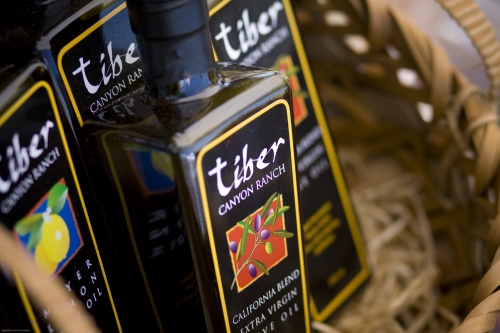
Peggy: And olive oil.
Michael: What kind of market do you have for that?
Chris: For the most part, our production is still pretty small, so we sell almost all of it here on the ranch, or at the olive festival, or online. We sell out. There have been years where our production is higher, and we have sold wholesale, mostly at We Olive. Hopefully that will be back.
Michael: We've been in We Olive and asked about you, and they said, "Oh, we'd like to have their olive oil."
Will: We just got a call today from We Olive in Ventura, and they wanted, thanks to you, our yuzu olive oil. [Yuzu is an aromatic Japanese citrus fruit that Peggy introduced to Chris & Will a few years back.]
Peggy: Oh, very good.
Will: So I said, "Next year." This is going to be a very good year.
Chris: I just got an email from the wedding we had a couple of weeks ago. The bride is Japanese. And one of her relatives from San Francisco bought a bottle of Yuzu olive oil while he was here, and he sent me an email just going crazy. He said, "I just got it, and I ate a half a loaf of bread just sopping it up. I just love it!" So that was neat.
Peggy: I know! We want to plant more yuzu.
Will: I'm looking for more trees. We'd buy them from you too.
Michael: Do you ever get any rest? ever? I can't see where in what we have talked about.
Chris: We went to Parkfield.
Michael: But you were selling popsicles!
Chris: It's kind of crazy, and I'm getting tired. [Pause] No, we don't. I sit down and read for half an hour and I feel guilty.
Will: Or you go to bed and read for five minutes and you're out.
Chris: So no. We don't.
Will: I think we're going to get smarter someday and work less.
Chris: I'm waiting for that to happen.
Michael: However, I don't see any remorse or regret about any of it.
Will: No.
Chris: If we lived in a horrible place, that would be different. But it's what we have to do to live here so I'll do it.
Michael: And you seem like you are making choices that you enjoy in order to make it.
Chris: Yes.
Will: We always can fall back on one thing. We can say, "Well, at least we're creating a lot of good will."
Michael: you are doing that. I can attest to that.
Peggy: You didn't do the tomato starts this year. That was new. [We and a lot of other people used to buy our starter tomato plants from Chris & Will each spring.]
Chris: This year I passed the tomato starting baton on to the Transitions Mental Health farm. They grew beautiful plants and sold them at our Tomato Fandango, which helped raise a lot of money for their wonderful programs.
So instead, I chainsawed out all the dead wood around the place.
Will: The worst thing that can happen to us is finishing a project before we thought we would be done, because then you just take on more work.
And Chris and her friend Lorrain Conlen did take out a lot of brush. It took eight of us two days to chip it. I mean there were mountains of brush up there. And it's a really good thing because, first of all, I'd never do that, and it's a huge fire danger.
Chris: I love the way it looks, and Lorraine sculpted those trees and got all of the dead stuff out of the oak trees. I had been wanting to do it for a long time and what really pushed me over the edge was we taught some glass blowing classes this year, and one of our long time students is the former fire chief from Arroyo Grande, and he was looking out the window and he said, "You know, if you guys wanted to clear out some of this brush, I would come help you chip."
Will: We worked his butt off.
Peggy: He regretted the day he said that. [Laughter]
Chris: "I need to be more careful about what I offer."
Will: But he did come. He worked really hard. He's a great guy.
Michael: So a couple more questions. One is, do you have any other plans? Anything else on the horizon?
Will: I think I'd like to be an artist again.
Chris: I want to build Gypsy Caravans.
Will: Yeah, Gypsy Caravans! I'm just spending my time building trailered pizza ovens and concession trailers so I'll know how to build a really nice Gypsy Wagon. We're both really enthused about Gypsy Wagons.
Michael: That sounds great!
Will: We have an old '43 dodge flatbed truck. It's about a three ton truck. It's going to be our first victim.
Michael: Do you ever look at the Tiny House blog?
Chris: Oh yeah. Well, not the blog but we have the book.
Michael: There's a whole web page that posts all the time.
Chris: Yes, I have seen that.
Will: It's a good thing I don't know how to use the internet because I'd be looking at all kinds of stuff like that.
We'd love to travel again. We used to do a lot of traveling, and we don't do that much any more. Except to go to Austin Texas. That was fun.
Peggy: You were talking about Airstreams. There's a guy in Colorado who's a ceramic artist who goes around and sells his ceramics out of an Airstream. I guess he does a Colorado festival circuit, and he outfitted this airstream for it, and it's just beautiful. Or this other sculptor we know about from L.A. innocently commented on Facebook one day that it would be fun to sculpt across America.
Michael: Meaning teach workshops.
Peggy: Yeah. And within three hours on Facebook she had all these people telling her places to go. I sent her a note about people we know in Paducah, Kentucky who have an art gallery and school. Paducah was an old abandoned downtown basically, and they enticed artists there and there are like 70 artists in this little downtown district there.
Michael: Tax breaks and incentives and such.
Peggy: She didn't go there but this was two years ago, and she traveled for six months all across the country...
Michael: Had a trailer with all her supplies and equipment, and she'd show up at your art center, teach a sculpture class for a week and head on down the road to the next place. Went all over the country. And it was all just from this innocent comment she made, and she got such a response, and so many leads on places to go, that she decided to do it.
Will: That's how it happens. It isn't just crazy ideas. It's something on the back burner, and you start thinking about it more and it happens. I'd like to do more educational things in the future.
Michael: You do teach classes from time to time.
Will: We teach glass classes. I think we should teach more. There are a lot of things we could teach. I think all of us should teach. Teach younger people how to do stuff.
Chris: The other thing we didn't talk about that is not us, is that we have a resident ceramic artist who has a studio in the other half of the wood shop up there. Eddy Cosko. He has a wheel, and we have a slab roller, and we inherited this giant gas kiln from our neighbor, Liz Mertz, down the hill, a long time ago. Will moved it up here with a huge road-going forklift, and we set it on a slab up there, and it sat there. And last year Eddy brought it back to life, got a propane tank set up and has had two or three firings in it.
Will: He's been throwing pots.
Michael: So you have the beginnings of a colony.
Chris: Oil painting classes. She teaches a specific color theory.
Peggy: What's her name again?
Will: : Debra Sievers.
(some of her art can be seen at http://www.visionsfineart.com/sievers/aa_index.html)
And Eddie has been teaching some people. He's been teaching some kids.
Chris: Way back in the way back we thought we would have an art school here. That went away, but who knows.
Michael: Maybe it will grow itself.
Chris: It seems to be.
Will: I'm getting more enthused about going back into blacksmithing. I never did a lot of it, but I've always been interested in it. And I always seem to be running into blacksmiths. I'll probably join the California Blacksmith Association in a while.
Peggy: Are there a lot of blacksmiths around here?
Will: Surprisingly enough, quite a few. Old Sully used to be Sully Art and Iron down in San Luis, and Peter Fels up at Piedras Blancas—he's an incredible blacksmith.
Peggy: I've heard that name.
Will: I just met a guy, his name is Chuck Carter, down in Orcutt. He's a welding inspector and old pipeline welder.
Chris: He had a teeshirt on from the John C. Campbell Folk School in North Carolina. I started talking to him about it and he and Will started talking about blacksmithing.
Will: I think there's a lot of interest in this area. And it leads into other friends of ours besides you who work metal and have always worked metal.
Michael: Mike Hannon.
Will: Mike does amazing figurative sculpture as a copper smith and there's a lot of people who work metal around here.
Michael: The concentration of creativity around this county is pretty remarkable. There's all kinds of things going on. It's really amazing.
Will: You've certainly proven that, by getting all those people into one art show.
Michael: Yeah, that Phantom Project, the second show is pretty amazing. I had no idea we could get that much talent.
Will: So I have a question. Who's going to interview you guys.
Michael: I don't know! [Laughter]
We're working up to the point where we'll have something to say.
Peggy: We just had our first guest writer.
Chris: Linda?
Peggy: Yes.
Chris: She forwarded her article to us.
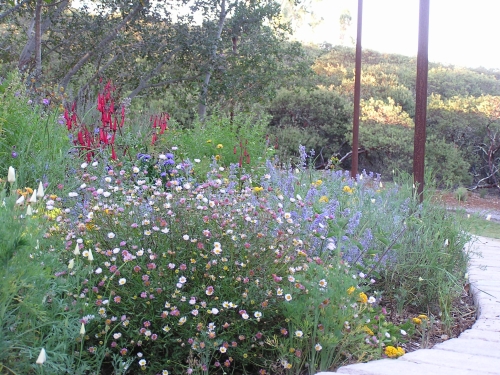
I just wanted to interject something about the venue. I was a horticulture major at Cal Poly, and have always loved doing landscaping stuff and dirt and all of that. So I feel like I've finally made myself a job where I get to play in the dirt.
Will: Yeah, Chris does all this.
Chris: And Lorraine helps me.
Michael: It's really remarkable what you do. Over the years we've watched it grow.
Will: The interesting thing about having this as a wedding venue, is that any time of year, any time of day, there are always people coming to look at this place. So it makes Chris keep everything neat and in order. I don't know how she does it with all the other stuff she does.
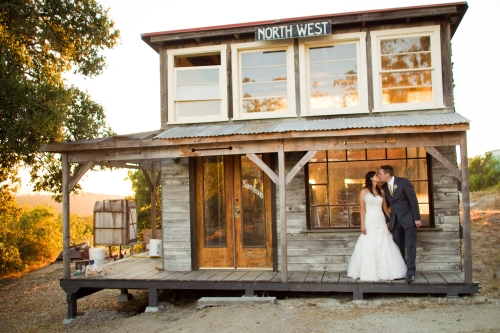
Chris: Before we had this as a venue, when an event was coming up it was this giant thing two weeks ahead of time to get everything cleaned up and put away, and now, it's pretty neat all the time. Except right now because we're going to stain the floor downstairs so we had to take everything out.
Peggy: Is it bare concrete now?
Will: We got back from Austin, our first vacation in quite a while. and immediately jumped in having our annual Tomato Fandango, and then we had to get ready for the first wedding we had, and now there's nothing to do. So Chris wants to tear everything out of the barn and redo the floor.
Chris: It was on my list to do before we went to Austin, it just didn't get done.
Will: I wish I had kept all the lists I ever made. It would fill the barn and be very interesting to sit back when we retire and look at all the lists.
Chris: I keep them all in little spiral notebooks.
Peggy: His lists or your lists?
Chris: My lists. It helps me when we are redoing the same event. But then I look back at things from five years ago and go, "Oh, my god! Look at all we've done in the last five years."
Will: I'm not sure if time is slowing down or speeding up. We get so much stuff done.
Chris: My theory of time is that we were in Parkfield on Sunday, and now it's Tuesday, and it seems like two weeks ago. And that's because the more you cram into every minute, the longer it seems. People who sit around and do nothing, it seems like time must go fast for them.
Will: We just sat down with a 17 year old kid who has no idea what he's going to do with his life, and I thought, "He's wasting so much time!" And I know I did the same thing as a younger guy, and had no clue what I was going to do, but it's something we all have to think about—how to organize our time.
Chris: Are you running out of time on the recorder?
Michael: No, we've got about 30 hours left. [Laughter] But you mentioned the 17 year old kid, and that brings me to our wrap up question. We don't have to stop here if you have more to say, but I'll toss the question out. My wrap up question is always, " What advice would you give to a 17 year old kid who wants to make a creative life.
Will: Keep a sketchbook. Keep a record. Go to art school. What would you say?
Chris: Don't get married when you're 18. [Laughter]
Peggy: Is that what you did?
Chris: Yup.
Peggy: You were 18?
Michael: I was 21 but it would have been good advice for me too.
Peggy: But that was a different husband.
Chris: Well, thank you, but yes.
Will: How can you be young and open your eyes faster and become more aware? Whatever you can do to become more aware. But everybody's different.
Peggy: You said art school, and we've heard both things—go or don't go—from different people. I don't know.
Chris: I don't think you necessarily mean art school.
Will: Richard Ritter was a teacher at Penland. He was showing in galleries. And he had a tech at Penland, who was very promising, and he said, "Look, you've gone as far as you can in this craft school. You need to go out and get more education and find a basis to hang your designs on. A lot of us can get so carried away in learning the craft—I'm certainly one of them, although I'm fortunate to have the design background in architecture school. But you need to go into some kind of ecducation process to really build a sound theory. Being an artist is not just being crazy and throwing things together for reasons nobody can ever figure out. There has to be some basis for it.
Michael: A couple of weeks ago I took Chris Winfield, one of the jurors for the Phantom show to lunch and we were talking, and he made an interesting comment along those lines. He actually was talking about the work we had in the show, and he said we had a very wide diversity of work in the show. And it's very clear that some of the artists are self taught. He said there's nothing particularly wrong with that but you need to educate yourself about what's happened in art, and about things beyond the narrow walls of your own experience. And I think that's probably what you're getting at.
Will: That's what Richard Ritter was saying, that stuck with me. You have to have something to hang your hat on. A reason for expressing those emotions. It's very important.
I'm for one, very interested in educating younger people in vocational technical things because I think it's completely void in this society anymore. And it's a real crime that it's gone. Soon, we won't know how to do anything. And knowing how to work in the physical reality is a very important thing.
Michael: They've discontinued the welding program at Cuesta College now, for example.
Chris: You're kidding!
Will: It's too bad, but apparently the situation with the administration or the state funding has brought that about. It's a shame. My dad was taught how to work wood so they could then go to the foundry to make something. They worked wood to make a pattern so they could cast a gear in industry. And that's totally out the window.
I just met a kid, he was actually making wood fired pizza ovens, Giuseppe's, and he said he was in school in
Oregon, and he had a foundry class. And that taught him everything he needed to know. It made his awareness to pick up everything he needed to know around working metal. That exposure in school set up a lifelong interest that he then turned into making a stainless steel oven on a wood fired pizza oven. And he does all kinds of outdoor fireplaces and landscape environments.
Chris: So do you want popsicles?
Peggy: Oh, yes!
Chris: And I can show you the pictures of the pizza oven.
[And that was the end of that!]
| 
















